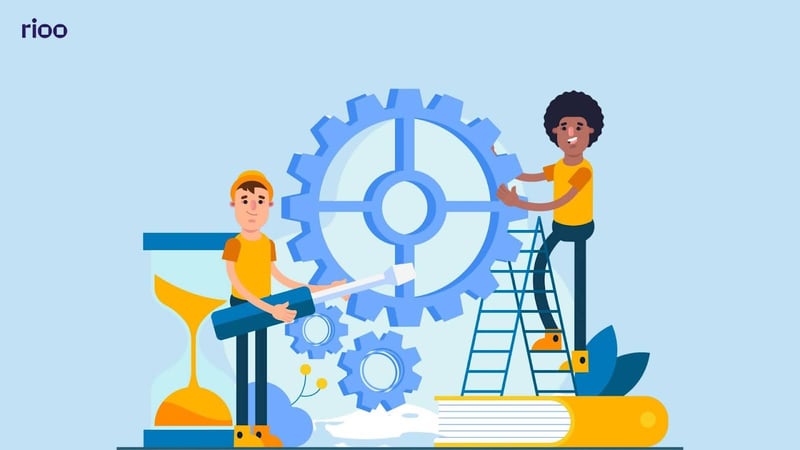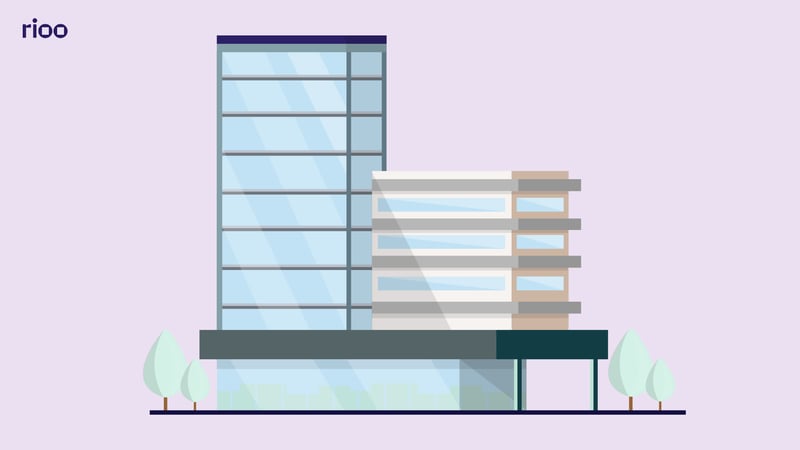Managing a facility involves juggling responsibilities like keeping equipment running smoothly and having clear, objective views of facility performance. Staying on top of countless maintenance tasks and avoiding costly downtime can be challenging.
We understand how overwhelming it can be to balance urgent repairs with long-term maintenance goals. Without the right tools to measure performance, it's easy to get caught up fixing problems after they happen instead of preventing them early.
You can save money, improve efficiency, and keep your facility running at its best when you track the right KPIs consistently. This guide will walk you through the 10 essential KPIs every facility manager should track.
What are the Key Performance Indicators (KPIs) for Facility Managers?
Key Performance Indicators (KPIs) in facility management help managers understand how well their buildings, systems, and services perform. These KPIs give insights into whether the facility is meeting business goals and where improvements are needed.
For example, if equipment is constantly breaking down and repairs are costly, a KPI can help managers spot this trend. This insight allows them to shift towards more preventive strategies, saving time and money in the long run. While KPIs focus on goals, general metrics provide raw data. Let's discuss how they differ.
Key Performance Indicators vs. Facilities Management Metrics
Here is the common point of difference between the two concepts:
|
Aspect |
Facilities Management Metrics |
Key Performance Indicators (KPIs) |
|
Definition |
Individual data points showing what is happening |
Measures performance against a specific goal using one or more metrics |
|
Purpose |
Descriptive shows activity or usage |
Evaluative shows whether performance is meeting targets |
|
Example |
Number of hours spent on maintenance this month |
Ratio of planned maintenance to reactive maintenance |
|
Indicates Good or Bad? |
Not necessarily, just raw data |
Yes, directly indicates performance quality |
|
Used For |
Monitoring specific tasks or inputs |
Tracking outcomes and guiding strategic decisions |
|
Data Context |
Often standalone and lacks goal orientation |
Always goal-driven and used to assess effectiveness |
So while facilities management metrics help you see what’s happening, key performance indicators in facilities management help you understand why it matters, and whether things are improving or falling behind.
Want to automate this difference? RIOO’s KPI dashboard labels metrics vs. KPIs automatically so you can see what needs action.
Why are KPIs in facility management Important?
They provide a clear, objective view of how your facilities are doing. With reliable facilities KPIs, you can:
-
Plan maintenance schedules more effectively
-
Reduce operational costs
-
Improve energy efficiency
-
Boost staff productivity
-
Stay compliant with safety and regulatory standards
Facility management comprises four key pillars: operations and maintenance, project management, real estate management, and sustainability. Each represents core functional areas essential to effective facility management.
Here are the key points explaining each pillar of facility management:
1. Operations and Maintenance
-
Daily facility operations like cleaning, security, utilities management, and equipment maintenance
-
Preventive and reactive maintenance scheduling to keep systems running efficiently
-
Ensuring safe, comfortable environments for all building occupants
2. Project Management
-
Planning and executing facility improvements, renovations, and capital projects
-
Managing budgets, timelines, and contractor relationships for construction work
-
Coordinating space reconfigurations and technology upgrades
3. Real Estate Management
-
Space planning and allocation to maximize utilization and efficiency
-
Lease management, property valuations, and occupancy optimization
-
Strategic decisions about acquiring, disposing of, or reconfiguring properties
4. Sustainability
-
Energy efficiency initiatives and environmental impact reduction
-
Waste management programs and resource conservation efforts
-
Green building certifications and compliance with environmental regulations
Understanding these helps align KPIs to core facility functions. Moreover, when you track KPIs over time, they help you set achievable targets and monitor progress.
This turns your facilities management KPI dashboard into a powerful decision-making tool that aligns day-to-day activities with long-term business goals. Now, let’s look at the top 10 KPIs every facility manager should track.
What Are The 10 Essential Kpi’s In Facility Management For Success?
Facility Management KPI Overview
|
KPI |
Purpose |
Formula |
|
Planned vs. Reactive Maintenance Ratio |
Tracks balance between proactive and emergency maintenance |
(Number of Planned Maintenance Tasks/ Number of Reactive Maintenance Tasks) |
|
Work Order Completion Time |
Measures task resolution speed and team efficiency |
(Work Order Completion Date – Work Order Request Date) |
|
Preventive Maintenance Compliance |
Monitors adherence to scheduled maintenance plans |
(Number of Completed PM Tasks on Schedule ÷ Total Scheduled PM Tasks) × 100 |
|
Equipment Downtime |
Shows how long assets are out of service |
(Downtime End Time – Downtime Start Time) |
|
Spare Parts Turnover Rate |
Evaluates spare parts usage vs. inventory levels |
(Total Cost of Spare Parts Used ÷ Average Spare Parts Inventory Value) |
|
Total Facilities Management Costs |
Tracks overall operational spending |
Sum of All Facility-Related Costs (Labor, Utilities, Maintenance, etc.) for the Period |
|
Utility Costs per Sq. Meter/Foot |
Assesses energy and resource efficiency |
(Total Utility Cost ÷ Total Area in Sq. Meters or Sq. Feet) |
|
Space Utilization Rate |
Measures how effectively space is used |
(Actual Occupied Space ÷ Total Available Space) × 100 |
|
Employee Turnover Rate |
Indicates workforce stability and engagement |
(Number of Departed Employees ÷ Average Number of Employees) × 100 |
|
Customer Satisfaction Rate |
Reflects user satisfaction with facilities and services |
(Number of Positive Responses ÷ Total Survey Responses) × 100 |
KPI #1: Planned Maintenance vs. Reactive Maintenance Ratio
A critical KPI in facility management is the ratio of planned maintenance (scheduled, preventive tasks) to reactive maintenance (unscheduled repairs), which indicates the balance between proactive upkeep and emergency fixes.
-
Planned maintenance includes regular inspections, filter changes, and lubrication to prevent unexpected breakdowns and maintain efficiency.
-
Reactive maintenance occurs only when repairs are needed after a breakdown. Over-reliance on reactive maintenance can increase repair costs and downtime.
By tracking this KPI, facility managers can take action to move from a reactive to a proactive approach, which is usually more efficient, cost-effective, and better for long-term asset health.
KPI #2: Work Order Completion Time
Work order completion time measures the duration between reporting a maintenance task and its completion, reflecting team efficiency and responsiveness.
This key performance indicator helps facility managers understand how efficient and responsive their team is, and whether the right processes and resources are in place.
If assets stay out of service for too long, it can lead to safety concerns, unhappy occupants, and even revenue loss. Extended work order resolution time may also reveal gaps in staff training or a lack of available tools and spare parts.
Common reasons for delays include:
-
Approval Issues
-
Poor inventory control
-
Longer delivery times for parts or materials
-
Overloaded or undertrained maintenance teams
Using a facilities management KPI dashboard can help you monitor this metric more closely. In many cases, adopting modern work order software is a simple yet effective way to improve completion times and streamline operations.
Try RIOO's facility management software, which can ease this process by automating approvals and inventory access with digital tools.
KPI #3: Preventive Maintenance Compliance
Preventive maintenance compliance, also called schedule compliance, tracks whether maintenance tasks are being done on time and at the correct intervals. This is one of the most essential facilities KPIs, as it shows how well your preventive maintenance program is performing.
Low compliance rates are usually the result of:
-
Limited access to assets
-
Missing tools or spare parts
-
Insufficient training
-
Lack of time or staffing
To improve this facility management KPI, ensure your team has the right support and resources. A reliable facilities management KPI dashboard can help you spot issues early and stay on track with maintenance schedules.
Monitoring this KPI alongside other facilities management metrics helps you build a more proactive, cost-effective strategy.
KPI #4: Equipment Downtime
One of the most crucial KPIs in facility management is tracking equipment downtime. After all, facilities don’t invest in assets just to let them sit unused. When a machine or system breaks down, the goal is to get it back up and running fast; otherwise, it could lead to:
-
Frustrated clients
-
Revenue loss
-
Safety concerns
This key performance indicator in facilities management measures when an issue is reported and when it’s resolved. If this downtime is increasing, it's a red flag that your maintenance process or your facilities management metrics may need a closer look.
Also Read: Why Mobile Access Matters in Facility Management Today
KPI #5: Spare Parts Turnover Rate
The spare parts turnover rate is an important KPI in facility management. It tells you how efficiently you're using your spare parts.
The total cost of spare parts used during a period is divided by the average value of spare parts inventory held during that period. A high turnover rate suggests efficient use of spares but risks stockouts, while a low rate may indicate overstocking and tied-up capital.
Monitoring this facility KPI helps you strike the right balance between having enough spares on hand and not overstocking. It’s a key part of running an efficient facilities management KPI dashboard and making data-driven decisions.
KPI #6: Total Facilities Management Costs
One of the foundational KPIs in facility management is understanding your total operational costs, whether monthly, quarterly, or yearly. This facility management KPI gives you two powerful advantages:
-
You can benchmark your performance against industry standards
-
You can spot cost trends before they become issues
If costs suddenly spike or drop, it's a sign to investigate further, as changes may result from new unexpected issues. Either way, this facilities KPI gives you the big picture needed to take smart, informed actions.
KPI #7: Utility Costs per Square Meter or Square Foot
This is a key facilities management metric that helps track how efficiently your building uses power, water, and other utilities. By measuring energy costs per square meter (or foot), you get insight into:
-
Asset performance
-
Maintenance effectiveness
-
Occupant habits
Monitoring utility use over time helps you make strategic changes. For example:
-
Increase preventive maintenance for HVAC systems to reduce energy use
-
Install energy-efficient LEDs
-
Use motion sensors to control lights and HVAC systems
-
Educate tenants on small daily habits that reduce energy waste
This KPI in facility management not only improves sustainability but also lowers long-term operating costs, making it a win-win for your facilities management KPI dashboard.
KPI #8: Space Utilization Rates
Space is one of your most valuable resources. That’s why space utilization is a crucial key performance indicator in facilities management. These facilities KPI measures:
-
How often a space is used versus how often it’s available
-
How many people use the space compared to its full capacity
Knowing your space utilization rate helps you decide whether you need more space or if you could be using less. It's a great tool for making cost-effective, strategic decisions and improving how clients and employees use your facilities.
Also read: Key Challenges in Facility Management and How to Overcome Them
KPI #9: Employee Turnover Rate
This Kpi is all people-focused, but also matters in KPI facility management. A high employee turnover rate often points to low job satisfaction, poor engagement, or workplace challenges.
Keeping good employees is always cheaper and smarter than constantly hiring and training new ones. This facility management KPI helps you track:
-
Monthly and annual turnover
-
Voluntary vs. involuntary departures
Employee turnover rate reflects staff retention issues; facility managers can use this KPI to assess workplace conditions, improve environment and safety, and collaborate with HR to enhance employee engagement.
Employee Turnover Rate measures how often staff leave; facility managers can use this KPI to identify workplace issues affecting retention and collaborate with HR to improve the work environment.
KPI #10: Customer Satisfaction Rates
Finally, don't overlook the voice of your client. This KPI in facility management reflects how well your facility supports the people who use it, tenants, employees, or customers.
Common ways to measure this include:
-
Satisfaction surveys
-
Online reviews
-
Usage patterns and complaints
-
Speed of service and safety reports
Even negative feedback is valuable; it helps you improve. High satisfaction rates show you're delivering a clean, safe, efficient, and welcoming space. Tracking these facilities management KPI helps strengthen client relationships and boosts the overall reputation of your facility.
Use Maintenance Software to Track Your KPIs and Performance Metrics
Manually tracking facility management KPIs with spreadsheets takes a lot of time and is prone to mistakes. This approach often means you fix problems only after they occur, rather than stopping them early.
Modern facility maintenance software, like RIOO, automates data collection, analyzes trends, and turns numbers into actionable insights so you can optimize performance.
Why Manual Tracking Fails
-
Human errors: Missed entries or outdated spreadsheets skew your data.
-
Delayed insights: By the time you spot a problem (like rising reactive maintenance), it’s already costing you.
-
No real-time visibility: Can’t make quick decisions without live data.
How RIOO’s Maintenance Software Solves This
-
Auto-Tracks Critical KPIs
-
Automatically tracks key performance indicators, including maintenance types, equipment downtime, and work order completion times, updating your dashboard instantly without manual entry.
-
-
Flags Problems Before They Escalate
-
Alerts you if emergency repairs spike or PM compliance drops.
-
-
Generates Proof for Stakeholders
-
Share automated reports showing:
-
Cost savings from preventive maintenance
-
Efficiency gains (e.g., faster turnaround times)
-
Compliance progress (safety inspections, certifications)
-
-
-
Integrates with Your Tools
-
Pulls data from IoT sensors, accounting software, and CMMS to give a unified view of performance.
-
Conclusion
With the above guide, you can gain a data-driven, performance-focused approach to facility management, reducing risks such as unexpected breakdowns, budget overruns, and compliance issues. To further strengthen your facility management process, RIOO can be your all-in-one maintenance platform.
RIOO automates data collection, provides real-time insights, and transforms complex metrics into actionable strategies. So you can prevent problems before they happen, optimize your maintenance budget, and confidently manage facilities.
Try RIOO today and see how it simplifies facility management with practical, real-time insights!
Book your personalized RIOO demo now →















